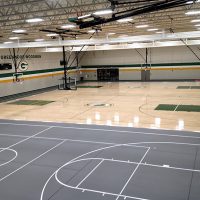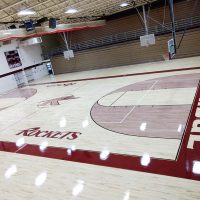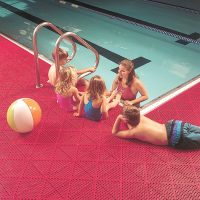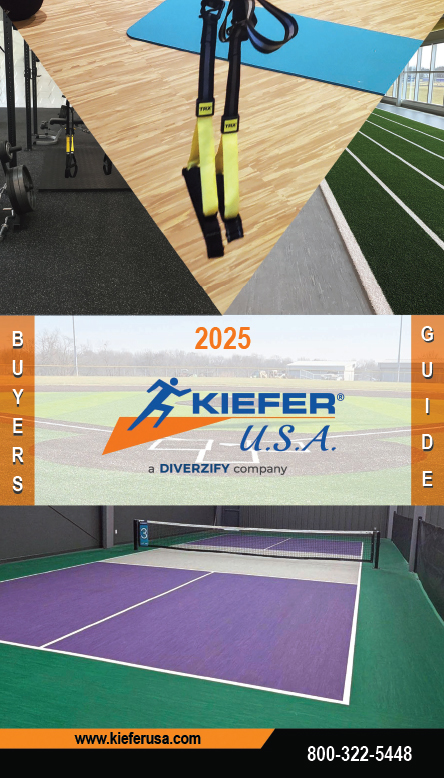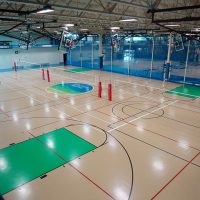
Gym Flooring Options Explained
Whether in schools or at a recreational center, gyms provide people with opportunities to competitively shoot hoops, bench 150-pound weights, or jazzercise to the latest in music. Gym floors are designed to withstand the repeated pounding and foot traffic from athletic use. Depending on the type of usage, certain gym floor materials are better suited to satisfy the needs of players and coaches.
Option 1: Maple Hardwood Flooring
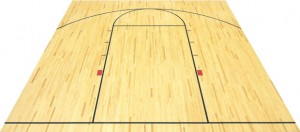
Maple hardwood flooring is found extensively in indoor courts, giving school sports teams similar surfaces to practice and play on, whether at home games or away. Young athletes become accustomed to hardwood courts as they advance to competitive levels. Naturally, hardwood courts are widespread.
Three grades of maple hardwood floors are available: First grade maple features a uniform look, with almost zero visual defects. Second grade maple is the most common with its slight color variations and knots. Third grade maple, riddled with plank knots and color differences, is the least expensive.
Given the strength and resilience of maple hardwood flooring, it is no wonder bowling alleys choose this type of floor. Like bowling alleys, gyms built with maple hardwood flooring are able to endure long-term. Coaches focus on the game without worrying about floor dents and durability.
When covered in a transparent finish, maple hardwood flooring is visually attractive. However, the floor requires sanding and refinishing every decade. Screening and recoating the floor should be scheduled yearly. Regular upkeep includes dry mopping and cleaning with recommended liquid solutions.
Option 2: Pad and Pour Polyurethane Flooring
Entirely seamless, pad and pour polyurethane floors are among the toughest in sports flooring. With multi-purpose properties, pad and pour polyurethane flooring is ideal for indoor gym sports. Excellent shock absorption results from the floor being cushioned with a layer of shock padding.
Facility managers are inundated with color choices when it comes to pad and pour polyurethane floors. The floor surface colors can be customized to match school or company colors. Line colors may also be coordinated to arrive at specified color schemes.
The pad and pour polyurethane floors feature a nonporous surface, which makes them hygienic and effortless to clean. Maintenance is minimal. Quick restoration along the wear surface allows the floor to endure for the life of the gym. Minor repairs are also simple to perform.
Similar to hardwood flooring, pad and pour polyurethane floors are built to endure. Their dependable durability makes them a solid alternative to wooden flooring. Given their resilient features, the pad and pour polyurethane floors also stand up to the weight of gym bleachers and chairs.
Option 3: Vinyl Flooring
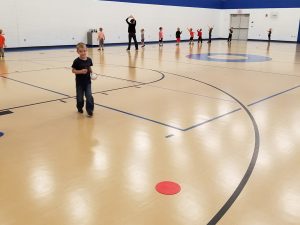
Vinyl floors are the most cost-effective gym flooring. Like pad and pour polyurethane floors, vinyl floors are available in a multitude of colors and patterns. Customization allows for facility managers to achieve a look that complements school or company colors. Vinyl floors can mimic the look of hardwood floors.
Ideal for a wide variety of sports, like volleyball and basketball, vinyl floors have multi-purpose characteristics. For example, a school gym may be used for not only sports but also for assemblies and events. The versatility of vinyl floors makes them common in K-12 school gyms.
Shock absorbent properties make vinyl flooring an ideal choice for sports. Athletes experience comfort when practicing and competing on vinyl floors. Durable and lasting up to 20 years (depending on play), vinyl floors are a quality product for all types of sports activities and events.
Minimal maintenance is necessary. Given that vinyl flooring is resistant to moisture and debris, cleaning is relatively quick and easy. Maintenance should include daily dry sweeping and the occasional wet mopping. Repair, however, can be difficult. Vinyl floors also cannot be resurfaced.
Option 4: Recycled Rubber Flooring
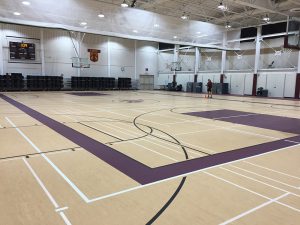
Resilient and long-lasting, rubber flooring is an optimum choice for gym floors. Rubber flooring is water-resistant, which prevents mold and mildew growth. In combination with air, soft rubber is created. Soft rubber goes a long way in circumventing the aches and pains common to gym users.
Recycled rubber flooring is made from old vehicle tires. Environmentally conscious facility managers might elect rubber floors in efforts to keep reusable waste out of landfills. Depending on the thickness of the rubber, these floors are built to withstand enormous weight on a daily basis.
Recycled rubber floors are easy to install but are not intended for competitive sports. Areas that are suitable for recycled rubber floors include weight rooms, fitness centers, and training rooms. Weight room equipment is heavy, making rubber floors ideal for dropped free weights and bulky machines.
Maintenance is necessary to keep rubber floors shining and free of debris. Mild detergent is practical, as harsh chemical cleaners are likely to erode the rubber. Vacuuming with a wet-vacuum should be on the daily maintenance schedule, especially in gyms that are used regularly.
When choosing a gym floor, it becomes essential to consider additional elements. Soundproofing, for instance, is important when wood floors are a top choice. Some flooring has the tendency to be slippery, so consider this fact when evaluating the types of sports meant to be played on the gym floor.
Option 5: Weightlifting Platforms
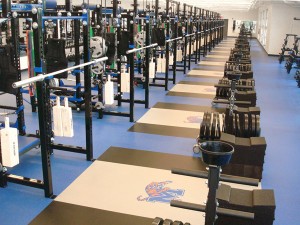 Weightlifting platforms are an option to consider for home gyms and weightrooms for schools and commercial gyms. These platforms are designed for heavy weightlifting with a hard surface flooring panel in the middle, typically made of wood, and rubber floor panels on either side of the middle panel that can absorb the weight of a dropped heavy loaded barbell. The middle panels of weightlifting platforms can also be customized with a school logo.
Weightlifting platforms are an option to consider for home gyms and weightrooms for schools and commercial gyms. These platforms are designed for heavy weightlifting with a hard surface flooring panel in the middle, typically made of wood, and rubber floor panels on either side of the middle panel that can absorb the weight of a dropped heavy loaded barbell. The middle panels of weightlifting platforms can also be customized with a school logo.
Types of Rubber Gym Flooring
Rubber has become the flooring material of choice for weightrooms at schools and commercial gyms as well as for home gyms. Rubber flooring is great at absorbing impacts which makes it ideal for cardio workouts and weightlifting, and it is a non-slip surface which helps prevent falls and injuries. It is also a durable flooring option as rubber is resistant to scratches, gouges, and dents, and as discussed above, rubber flooring is typically made in part with recycled materials. One thing you must remember about rubber flooring is that it is usually the more expensive flooring option.
The following are the main types of rubber flooring used in home and commercial gyms:
Gym Roll Rubber Flooring
Gym roll rubber flooring is rolls of rubber flooring that are usually 4 by 10 feet and about a quarter inch thick. They are ideal for small spaces like indoor gyms so that you can have a durable rubber surface within a particular room or use just what you need under your equipment.
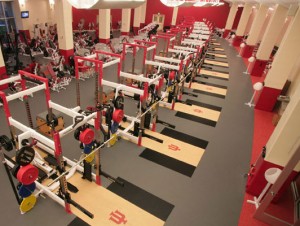 The following are the benefits of roll rubber flooring:
The following are the benefits of roll rubber flooring:
- Durability: Roll rubber flooring is extremely durable, and it can handle just about anything including weights and exercise equipment. If you use really heavy weights or equipment, you should consider roll rubber that is thicker than a quarter inch.
- Can be used anywhere: Rubber floor rolls can be used just about anywhere, including for small spaces or part of a room as well as larger areas. You can use roll rubber flooring to cover concrete in your basement, garage, or mudroom to create a home gym in these areas.
- Easy to clean: Roll rubber flooring is easy to clean as you can remove dust and debris simply by sweeping or vacuuming. You can also mop the floor with a neutral pH cleaner to remove stains.
- Applications: Roll rubber flooring can be used in a number of applications including home gyms, fitness centers, health clubs, weight rooms, school athletic facilities, ice skating rinks, physical therapy centers, and more.
Interlocking Rubber Flooring
Interlocking rubber flooring is flooring that consists of rubber tiles that interlock together similar to puzzle pieces. This flooring option is very simple to install, and it is a non-permanent solution so you can uninstall and store the rubber floor tiles between usage. You do not need special adhesives to install this flooring and when the pieces lock together, the precise fit makes the seams virtually invisible.
Interlocking rubber flooring is just as high-performing and resilient as other rubber flooring types and the tiles and be quickly and easily installed and uninstalled for storage, making them a great option for home gyms.
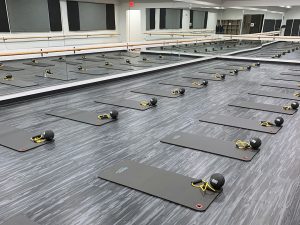 The following are the benefits of interlocking rubber flooring:
The following are the benefits of interlocking rubber flooring:
- Simple tile installation to cover a small area or entire room
- Easy to uninstall and store for a non-permanent solution
- No adhesive needed for installation
- Durable and resilient
- Slip resistant
- Easy to clean
- Seamless appearance where the pieces interlock
- Low odor
- Environmentally friendly
Interlocking rubber flooring can be used in weight rooms, laundry rooms, playrooms, cardio areas, rec rooms, and more.
Rubber Floor Tiles
Rubber floor tiles are made from vulcanized rubber that is highly durable, non-slip, and shock absorbent. This flooring type is heavy enough to offer a permanent flooring solution with double-sided carpet tape to keep it in place, but the tiles can also be used as a temporary gym mat. They can withstand heavy use and impacts from equipment and dropped weights and resist lacerations so they can last for many years.
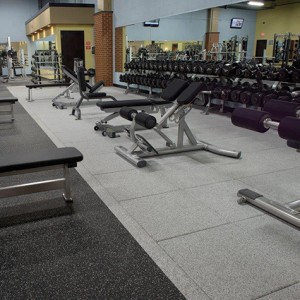 Rubber flooring tiles can be used for commercial gyms, ice rinks, locker rooms, school weight rooms, fitness centers, home gyms, and anywhere that could benefit from a highly durable rubber surface. The following are the main advantages of rubber floor tiles:
Rubber flooring tiles can be used for commercial gyms, ice rinks, locker rooms, school weight rooms, fitness centers, home gyms, and anywhere that could benefit from a highly durable rubber surface. The following are the main advantages of rubber floor tiles:
- Easy to install: Rubber floor tiles are easy to install and while it is recommended to have a professional help you install these floors, especially in commercial settings, you can install them yourself.
- Durable: Rubber floor tiles are durable and are resistant to scratches, gouges, and lacerations. They can last for many years with proper care.
- Shock absorption: Rubber flooring has excellent shock absorption to absorb the impact from those working out on the flooring and from heavy weights and equipment.
- Easy to clean: You can clean rubber flooring by vacuuming or sweeping the floor and you can mop the floor to remove stains.
- Anti-microbial: Rubber flooring is anti-microbial which means that it can resist bacteria and mold growing on the floor.
- Water resistant: Rubber flooring is water resistant, and it is non-slip surface, even when wet.
- Sound absorption: Rubber floors also absorb sounds from running and dropping weights.
The following are the main disadvantages of rubber flooring:
- Weight: Rubber flooring tiles and roll rubber flooring can be heavy. You will likely need help installing and uninstalling these floors because of the weight.
- Poor temperature insulation: Rubber flooring is a poor insulator when it comes to temperature. If you put a rubber floor over a cold concrete subfloor, the rubber may be cold to the touch.
- Price: While rubber flooring is highly durable and provides excellent value for its price, it does tend to be more expensive than other types of flooring.
- Smell: Sometimes rubber flooring may have an odor when it is new. However, the odor will dissipate over time, and you can help get rid of it faster by mopping the flooring and keeping the area well-ventilated.
Contact Kiefer USA
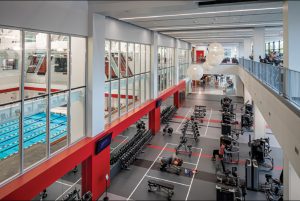 Environmentally friendly floor options are always a right choice. When you are considering rubber floors, look to Kiefer USA. As the premier installer and designer of gym flooring, Kiefer USA is a recognizable brand that gyms all across the country rely upon.
Environmentally friendly floor options are always a right choice. When you are considering rubber floors, look to Kiefer USA. As the premier installer and designer of gym flooring, Kiefer USA is a recognizable brand that gyms all across the country rely upon.
When weight room flooring is on the table, Kiefer USA offers quality options that stand up to the rigorous demands of strength training areas. Our weight room flooring options meet industry standards for performance, strength, durability and safety. Kiefer USA floors are known for their world-class look.
In addition to a pleasing aesthetic and top-notch quality, Kiefer USA flooring options stand the test of time. Kiefer USA non-porous floors offer triple benefits: they are mold-resistant, ADA compliant and do not require coatings.
Our professionalism starts with helpful, friendly field reps, extends through our reliable installation process and completes with long-term satisfaction from coaches, players and facility managers. Partner with the best in gym flooring by consulting a Kiefer USA representative.
